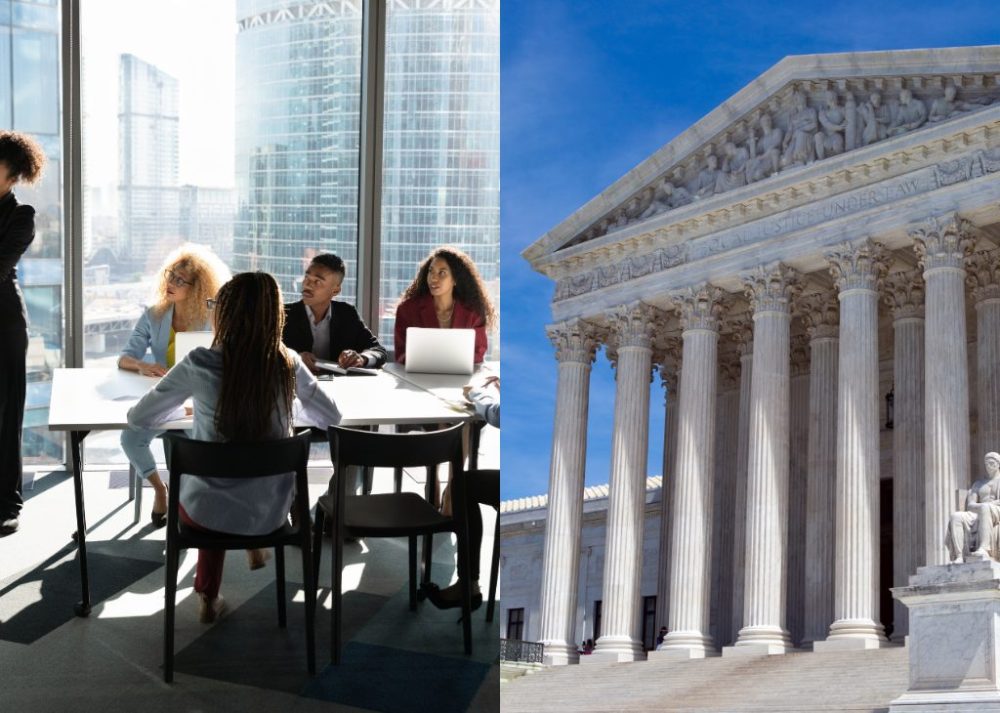
The U.S. Supreme Court handed down three high-profile decisions in 2023 that have major implications for public relations practitioners and communicators. While the impact of each of these cases, which involve affirmative action, fair use and copyright, and legal immunity for online platforms, is yet to be fully realized, communication professionals should expect to experience the residual effects of each of these decisions.
Ending Affirmative Action in Higher Education: Implications for Private Sector Diversity, Equity, and Inclusion (DEI)
One of the major shifts in U.S. higher education came with the ending of affirmative action in the cases Students for Fair Admissions v. President and Fellows of Harvard College and companion case Students for Fair Admissions v. the University of North Carolina. In these cases, the U.S. Supreme Court ruled 6-3 that considering race in college admissions violates the Civil Rights Act of 1964 and the Equal Protection Clause of the Fourteenth Amendment of the U.S. Constitution. The impact of this ruling will not be seen immediately, but many consider this a signal of a decreased focus on racial diversity in colleges. As a result, there is some indication that this decision will create a new style of admissions process (notably Harvard University stated it would continue to promote diversity while adhering to the ruling). In the communication industry, there may be shrinking racial diversity in recent college graduates that could result in a diversity decrease in public relations.
However, this ruling may have further implications beyond college admissions. Many in the private sector are asking whether this decision will usher in a new group of lawsuits concerning corporate DEI programs. The answer is likely not—for now. There is a practical and legal distinction between the affirmative action decisions in admission and DEI initiatives. For instance, in employment law there is established anti-discrimination laws in place for discrimination against race, religion, national origin, disabilities, age, and other characteristics. This is prohibited under Title VII of the Civil Rights Act of 1964 and a variety of state anti-discrimination laws. The Harvard and UNC cases were not decided under those laws, so the discussion around employment and DEI initiatives is a different legal conversation.
However, it is likely that there will be future lawsuits about DEI initiatives in the private sector that will ask the U.S. Supreme Court to extend its rationale beyond college admissions to private organizations. The results of these types of lawsuits remain to be seen. Despite how DEI is portrayed in the media, the field itself is highly complex and includes content that presents diversity broadly defined, including content and programming about raising awareness about a variety of issues such as unconscious bias, accessibility, salary transparency, gender, and sexual orientation. Because of that, DEI is not necessarily an item that directly relates to hiring and promotion decisions. However, communicators should be aware that this is a shifting legal landscape, and that DEI initiatives focusing on inclusivity writ large have a greater protection against legal challenges. Initiatives that could be interpreted as leading to certain hiring decisions based on protected characteristics a more vulnerable to lawsuits.
Because the challenges to DEI are coming from both private lawsuits and state laws, communicators need to stay current on the shifting legal landscape. Some states have proposed or enacted both laws that promote and eliminate DEI initiatives. All those state laws are also subject to constitutional lawsuits, notably Florida’s Individual Freedom Act, popularly called the “Stop WOKE Act,” currently enjoined by federal courts. Communications plays a role as well. As the legal landscape surrounding affirmative action and discrimination changes, it will be public relations practitioners who are tasked with explaining and communicating these measures to internal and external publics.
Fair Use and Copyright: The Future of Derivative Works
Public relations practitioners and communicators are always affected by any change in copyright law. Those creating content need to be especially careful of using copyrighted material in derivative works after the U.S. Supreme Court’s decision in Andy Warhol Foundation for the Visual Arts v. Goldsmith. This 7-2 decision, with a cross section of liberal and conservative justices in the majority, held that a silkscreen portrait derived from popular photograph of the musician Prince did not constitute fair use. The holding in this case has major implications for content creators. For owners of copyrighted works, it means that the transformative “purpose and character” element of fair use includes commerciality as a consideration. For communicators, this means copyright holders have a greater right of control of content. The downside for content creators, particularly artists and illustrators, is that when creating transformative work, fair use may not exist when the use itself is for the same commercial purpose as the original.
What does this mean? The U.S. Code Title 17 section 107 lists the four factors of fair use:
1.) Purpose and character of the use, including whether the use is of a commercial nature or is for nonprofit educational purposes.
2.) The nature of copyrighted work
3.) The amount and substantiality of the portion used in relation to the copyrighted work as a whole.
4.) Effect of the use upon the potential market for or value of the copyrighted work
In Warhol the image in question was a 1981 photo of Prince taken by Lynn Goldsmith for a Newsweek article on Prince as a new popular musician. Later, Goldsmith licensed the photo in 1984 for $400 to Vanity Fair magazine to use as the basis for an illustration in an article about Prince. Vanity Fair hired Andy Warhol to produce the illustration, which was a silkscreen portrait of Prince. Warhol created 16 versions of the silkscreen, one of which was entitled “Orange Prince.” Upon Warhol’s death, the Andy Warhol Foundation (AWF) held the silkscreens, and in 2016 Vanity Fair received a license from the AWF to use “Orange Prince” for its commemorative edition after Prince died. Goldsmith who received no compensation for “Orange Prince” and notified the AWF that she believed “Orange Prince” constituted infringement. AWF claimed the use of the photo was fair use because it was transformative of the original photograph. A lawsuit between Goldsmith and the AWF ensued with the U.S. Supreme Court analyzing the first factor of fair use “the purpose and character of the use.”
The U.S. Supreme Court held that the purpose and character of the use by Warhol did not constitute fair use. Specifically, the court held that “transformativeness” of the original photograph was not enough to constitute fair use under purpose and character. That transformativeness had to be considered considering commercial use of the new image, which in this case is the silkscreen. Because the original photograph in 1981 and the later silkscreen version of “Orange Prince” were commercial in nature, this weighed against fair use. After all, the original photograph and the later licensing of “Orange Prince” were for the same purpose and the same commercial ends—a magazine article about Prince.
This case has raised many questions about artistic creation, and there was a robust exchange in the opinion between Justices Sotomayor and Kagan who were on opposite sides. However, for communicators in commercial production of content, this case should serve as a cautionary tale. Getting the permission of copyright holders is even more important, even when the copyright at issue is one where something is transformed from the original. Licensing is a way to mitigate any uncertainty in the creation of content, and assuming fair use is a risky endeavor, especially because the establishment of fair use is not going to be determined unless a lawsuit is brought. In this case, fair use and its first factor has become more legally complex, and there may be more cases that emerge post-Warhol; the dissent in this case emphasized that the majority opinion will have the impact of stifling artistic expression. That may be. But the bottom line for communicators is that fair use is harder to prove than it used to be, and infringement cases against parties who commercially use content without permission have a higher likelihood of prevailing.
Legal Immunity and the Future of Online Liability
One of the biggest issues in recent years has been the legal immunity that internet companies have had from lawsuits arising from third-party content. Section 230 of the Communications Decency Act has been a rallying cry for the left and right in recent years with “cancel 230” becoming a political slogan in the past few election cycles. The Institute for Public Relations published a piece in 2020 on section 230 during the Trump administration’s attempt to remove its protection for internet companies that were perceived to be anti-conservative.
This past term, the U.S. Supreme Court waded into the discussion about section 230 but stopped short of making any changes to the immunity of online platforms. In Gonzalez v. Google and Twitter v. Taamneh the court heard a section 230 issue that involved terrorist-created internet content. The U.S. Supreme Court was thought to be potentially weighing the future of this important aspect of how the internet functions, but ultimately these cases were decided on grounds outside of section 230. There was a fear that the Court was ill-equipped with handing the technical implications of changing the protections of section 230. Justice Kagan acknowledged as much as she said in the oral argument, “I mean, we’re a court. We really don’t know about these things. You know, these are not like the nine greatest experts on the Internet” (Gonzalez v. Google, 2023, p. 45).
What this means for PR practitioners and communicators is the internet and its structure is here to stay for now. This immunity for organizations, such as social media platforms, that host third-party content protects them from an onslaught of lawsuits. While some Members of Congress have attempted to change the widespread immunity that section 230 provides, they so far have been unsuccessful.
This has real-world implications for communications practice, especially in terms of managing reputations, combatting fake reviews, and engaging with activist reviewers. Internet platforms that host third-party content, however untrue or defamatory, remain immune from lawsuits. Any changes on immunity will likely be legislative rather than judicial, and given the current gridlock in Washington D.C., an immediate change seems unlikely.
Going Forward
The U.S. Supreme Court’s decisions in 2023 have significant impacts on the communications industry in terms of DEI, intellectual property, and internet protections. Going forward there will be a continuation of changes to the industry. Currently, the U.S. and other nations are struggling to find the right balance between regulation and AI. The issue of privacy, discrimination, and civil rights will continue to be of top importance. Perhaps the biggest takeaway is that for public relations and professional communicators, the evolving nature of law is perhaps more important than ever. As the communication sector becomes more technological, philosophically, and economically complex, the impact of U.S. Supreme Court cases impacts not both how and what PR practitioners say.
References
17 U.S.C. §107.
47 U.S.C. §230.
Andy Warhol Foundation for the Visual Arts v. Goldsmith, No. 21-869 (U.S. 2023)
Gonzalez v. Google, No. 21-1333 (U.S. 2023).
Gonzalez v. Google, 21-1333, OT 2022-23, 1 (U.S. 2023). Retrieved from https://www.supremecourt.gov/oral_arguments/argument_transcripts/2022/21-1333_f2ag.pdf.
H.R. 7, 124th Leg. Reg. Sess. (Fla. 2022).
Students for Fair Admissions v. President and Fellows of Harvard College, No. 21-1199 (U.S. 2023).
Students for Fair Admissions v. the University of North Carolina, No. 27-707 (U.S. 2023).
Title VII, Civil Rights Act of 1964, 42 U.S.C. §§2000e et seq.
Twitter v. Taamneh, No. 21-1496 (U.S. 2023).

Cayce Myers, Ph.D., LL.M., J.D., APR is a professor and director of graduate studies at the Virginia Tech School of Communication. He is the Legal Research Editor for the Institute for Public Relations. He can be reached at mcmyers@vt.edu.



